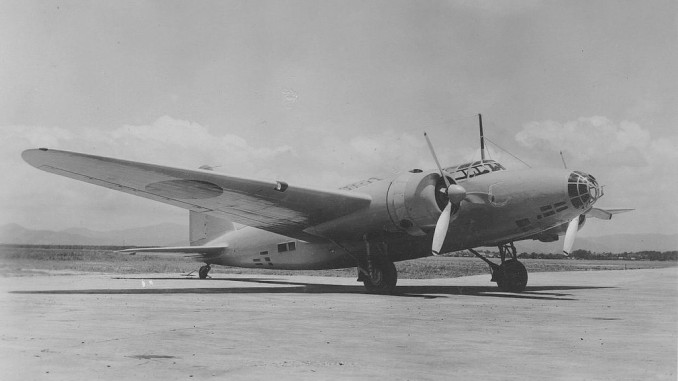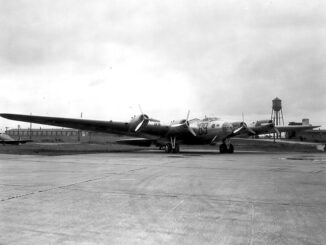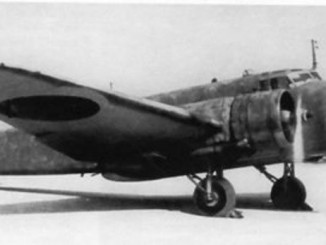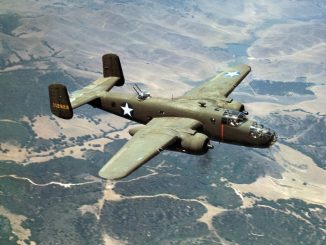
The Mitsubishi Ki-21 was a heavy bomber of the Imperial Japanese Army during the Pacific War. It was originally designed to meet a 1936 requirement of the IJA for a replacement for the Ki-1 and the top secret Ki-20 heavy bombers then available. The requirement called for much higher speed, endurance and bombload than any existing aircraft was then capable of. Designs by Nakajima and Kawasaki were rejected, but that of Mitsubishi was accepted as the Type 97 Heavy Bomber.
The Ki-21 was the Army’s first modern bomber aircraft, with a cantilevered mid-wing design, all-metal construction, retractable landing gear and a long greenhouse canopy. Fitted with Nakajima Ha-5 engines, the aircraft was capable of over 250mph, as the design contract required. Later models were capable of carrying a 1,000kg bombload, twice as much as the Navy’s equivalent G3M.
A few pre-production Ki-21s were rushed into service during the first months of the “China Incident”, but it was not until that conflict was a year old that the type began to see regular service. Ki-21s of the 60th and 61st Sentai were drafted in to assist the Navy G3Ms and Army BR.20s that began bombing Chungking and Chengtu in late 1938. Ki-21s were a common sight over the two cities as the conflict rolled on, and remained the primary Japanese bomber in China right up until the final surrender in 1945.
When the wider Pacific War opened, Ki-21s were still the Army’s primary heavy bomber and were used in that role against the Philippines, Malaya and Burma as the Japanese offensives opened. Although Ki-21s had proved capable against Chinese fighters, the modern types in use with Allied forces such as the Curtiss P-40 proved more than a match. Improved models with more powerful engines and extra defensive guns did not completely solve the problems with the bomber. Despite this, the Ki-21 remained in service until the end of the war, despite the arrival of replacements such as the Ki-49 and Ki-67 heavy bombers.
The Ki-21 was assigned the Allied Reporting Name “Sally” in 1942. Later the Ki-21-IIb was mis-identified as a new type and assigned the codename “Gwen” before the mistake was rectified and the new type was re-designated the “Sally III”. There is also an apocryphal story that the Ki-21 was codenamed “Jane”, after General MacArthur’s wife, before he objected and “Sally” was assigned instead. This story, however, does not make sense as the General’s wife was actually called Jean, and there appears to have been no objection to the codenaming of the B4Y Type 96 “Jean” torpedo bomber. Perhaps “Jane” was briefly assigned to the Ki-21-Ib (which had a re-designed tail and extra defensive machine guns) or the Ki-21-IIa (with more powerful engines) before it, too, was discovered to be a variant of the “Sally” – the “Sally II”. The codename “Doris” was also assigned to a non-existent “Mitsubishi B-97” bomber, which may have been confused with the Ki-21.
Mitsubishi Ki-21 Type 97 Specifications
| Mitsubishi Ki-21 | |
| Role | Medium bomber |
| Crew | |
| Powerplant | 2x Nakajima Ha-5 (850hp) |
| Speed | |
| Ceiling | 0ft |
| Range | |
| Armament | |
| Ordnance | |
| Dimensions | 0ft 0in (length) 0ft 0in (wingspan) 0ft 0in (height) |
| Weight | |
| Number produced | 8 |
| Mitsubishi Ki-21-Ia | |
| Role | Heavy bomber |
| Crew | 5 |
| Powerplant | 2x Nakajima Ha-5-KAI (1,080hp) |
| Speed | 268mph (max) |
| Ceiling | 28,200ft |
| Range | 1,680 miles (internal) |
| Armament | 3x Type 89 7.7mm Machine gun |
| Ordnance | 2,205lb bombs |
| Dimensions | 52ft 6in (length) 73ft 10in (wingspan) 14ft 3in (height) |
| Wing Area | 752 sq.ft. |
| Weight | 10,342lb (empty) 16,517lb (gross) 17,452lb (max) |
| Number produced | 143 |
| Mitsubishi Ki-21-IIb | |
| Role | Heavy bomber |
| Crew | 5-7 |
| Powerplant | 2x Mitsubishi Ha-101 (1,500hp) |
| Speed | 236mph (cruise) 301mph (max) |
| Ceiling | 32,800ft |
| Range | 1,680 miles (internal) |
| Armament | 1x Ho-103 12.7mm Machine Gun 5x Type 89 7.7mm Machine gun |
| Ordnance | 2,205lb bombs |
| Dimensions | 52ft 6in (length) 73ft 10in (wingspan) 15ft 11in (height) |
| Wing Area | 752 sq.ft. |
| Weight | 13,354lb (empty) 23,320lb (gross) 23,391lb (max) |
| Number produced | 688 |




Leave a Reply